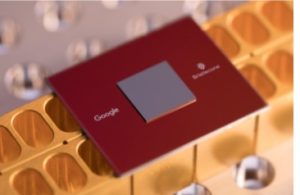 In this video from the HPC User Forum in Tucson, John Martinis from Google presents: Quantum Computing and Quantum Supremacy.
In this video from the HPC User Forum in Tucson, John Martinis from Google presents: Quantum Computing and Quantum Supremacy.
Google recently announced that the company has developed a new 72-Qbit quantum processor called Bristlecone.
The goal of the Google Quantum AI lab is to build a quantum computer that can be used to solve real-world problems. Our strategy is to explore near-term applications using systems that are forward compatible to a large-scale universal error-corrected quantum computer. In order for a quantum processor to be able to run algorithms beyond the scope of classical simulations, it requires not only a large number of qubits. Crucially, the processor must also have low error rates on readout and logical operations, such as single and two-qubit gates.
The purposeof Google’s gate-based superconducting system is to provide a testbed for research into system error rates and scalability of our qubit technology, as well as applications in quantum simulation, optimization, and machine learning.

Bristlecone is Google’s newest quantum processor.
Before investigating specific applications, it is important to quantify a quantum processor’s capabilities. Our theory team has developed a benchmarking tool for exactly this task. We can assign a single system error by applying random quantum circuits to the device and checking the sampled output distribution against a classical simulation. If a quantum processor can be operated with low enough error, it would be able to outperform a classical supercomputer on a well-defined computer science problem, an achievement known as quantum supremacy. These random circuits must be large in both number of qubits as well as computational length (depth). Although no one has achieved this goal yet, we calculate quantum supremacy can be comfortably demonstrated with 49 qubits, a circuit depth exceeding 40, and a two-qubit error below 0.5%. We believe the experimental demonstration of a quantum processor outperforming a supercomputer would be a watershed moment for our field, and remains one of our key objectives.
Googles believes Bristlecone would then be a compelling proof-of-principle for building larger scale quantum computers. Operating a device such as Bristlecone at low system error requires harmony between a full stack of technology ranging from software and control electronics to the processor itself. Getting this right requires careful systems engineering over several iterations.
We are cautiously optimistic that quantum supremacy can be achieved with Bristlecone, and feel that learning to build and operate devices at this level of performance is an exciting challenge! We look forward to sharing the results and allowing collaborators to run experiments in the future.
John M. Martinis attended the University of California at Berkeley from 1976 to 1987, where he received two degrees in Physics: B.S. (1980) and Ph.D. (1987). His thesis research focused on macroscopic quantum tunneling in Josephson Junctions. After completing a post-doctoral position at the Commisiariat Energie Atomic in Saclay, France, he joined the Electromagnetic Technology division at NIST in Boulder. At NIST he was involved in understanding the basic physics of the Coulomb Blockade, and worked to use this phenomenon to make a new fundamental electrical standard based on counting electrons. While at NIST he also invented series-array SQUID amplifiers. In 1993 he started an effort building high-resolution x-ray microcalorimeters based on superconducting sensors and series-array SQUIDs. This effort has grown to include applications in x-ray microanalysis and astrophysics, and optical and infrared astronomy. More recently he started a project to build a new fundamental standard of temperature based on noise thermometry, and in 2001 he helped initiate a project to use a microcalorimeter optical photon counter with high quantum efficiency for quantum communications. Since 2002 his research effort has focused on building a quantum computer using Josephson junctions.
He has pioneered many important demonstrations, including entangled states, Bell state violation, Fock and arbitrary photon generation, photon NOON states, and the quantum von Neumannn and RezQu architecture. In 2010, he was awarded with collaborator Andrew Cleland the “Science breakthrough of the year” for the first demonstration of the quantum ground state in a mechanical oscillator system. In 2014 he was awarded the London Prize for low-temperature physics research on superconducting quantum bits. Dr. Martinis was a NIST Fellow, and is a Fellow of the American Physical Society. At the University of California, Santa Barbara he currently holds the Wooster Chair in experimental physics. In 2014 he was awarded the London Prize for his pioneering work on superconducting qubits. In 2014, Dr. Martinis joined Google to head up their quantum-hardware effort. The aim of this research is to build the first useful quantum computer.




